Chapter 5
Extending Teams with Apps, Bots, and Connectors
IN THIS CHAPTER
![]() Discovering apps in Teams
Discovering apps in Teams
![]() Finding connectors to your favorite services
Finding connectors to your favorite services
![]() Installing and using popular apps
Installing and using popular apps
![]() Exploring the Power Platform apps
Exploring the Power Platform apps
![]() Getting chatty with your favorite bot
Getting chatty with your favorite bot
The world today is more interconnected than at any other time in human history. On the Internet, these connections take the form of software applications communicating with each other. Microsoft Teams embraces integration with all types of software in the form of add-on apps, bots, and connectors. Apps come in many flavors. You can find apps for personal use, for adding tabs and bots to your channels, for adding connections to other software services, and for enhancing your messaging experiences.
In this chapter, you discover how to find, install, and use apps in Teams. You learn about the apps created for Microsoft Office such as SharePoint, Word, Excel, PowerPoint, Planner, and OneNote and how they integrate with Teams. You also find out about some of the most popular apps developed by companies other than Microsoft such as Asana, Zendesk, Dropbox, Box, and Google Drive, and how you can add these apps to Teams as well. Finally, you discover how bots can help your Teams conversations as well as how Teams is becoming the primary hub for productivity with its integration with the Microsoft Power Platform.
That’s quite a lot! Let’s dive into the expanding world of Teams apps.
Discovering Apps Already Installed
If you are reading this book in order and created a new channel in Chapter 4, then you already have experience with apps. You might just not realize it yet because apps are designed to feel like part of Microsoft Teams. Every new channel you create includes two apps that show up as tabs at the top of the main Teams screen, as shown in Figure 5-1. These are the Files app and the Wiki app.

FIGURE 5-1: The Files and Wiki tabs in a channel.
The Files tab
The Files tab is an app that shows the files you have created and saved to a Teams channel, which is actually a SharePoint site that sits behind the scenes. And the Wiki tab is a Wiki page that also lives in the same SharePoint site. Did I mention that every team in Teams has an associated SharePoint site? You might never need to access it directly, but it is there behind the scenes offering up SharePoint functionality to Teams.
When you click the Files tab, you see a view into a SharePoint library. You can create new files, upload existing files, get a link to the library, add an additional cloud storage location (more on this shortly), and even open the library in SharePoint. Figure 5-2 shows the same library shown earlier in Figure 5-1, except it is open in SharePoint instead of Teams. If you add a file to either location, you will be able to see it instantly in the other location.
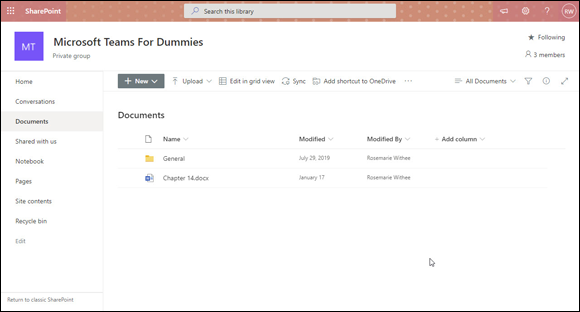
FIGURE 5-2: Viewing the Files of a Teams channel in SharePoint.
SharePoint is a product unto itself, and it requires its own book. If you are interested in learning more about SharePoint, check out Microsoft SharePoint For Dummies (Wiley).
The Wiki tab
When you click the Wiki tab, you see a page that you can customize for notes or documentation or pictures or whatever you want to add to it. The page is a SharePoint Wiki Page, and it lives in the same SharePoint site where your files in the Files tab live. Figure 5-3 shows the Wiki page of the General channel in the Portal Integrators team.
Both the Files tab and Wiki tab are apps that you can add to Teams. These apps provide integration with SharePoint, and there are other apps that provide integration with just about any other software you can imagine. Let’s look at those apps next.
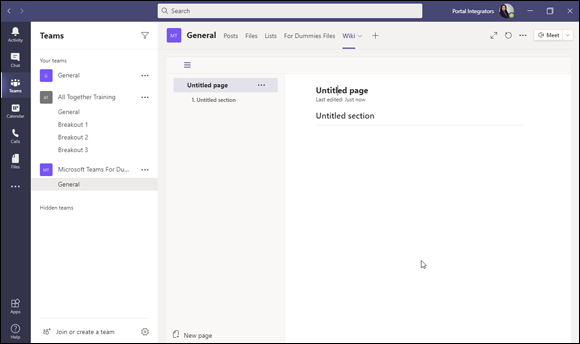
FIGURE 5-3: Viewing the Wiki tab in a Teams channel.
Browsing and Adding Apps
An app store is built right into Teams, and you can access it in several different ways. The easiest way is to open the settings for a team and browse to the apps. However, you can also view the available apps, bots, and connectors on a channel within a team. First let’s look at how to view and install the available apps via a team’s settings.
To view and install the apps available for Teams, follow these steps:
- Select the Teams app from the left navigation pane to view a list of your teams.
- Open the More Options drop-own menu by clicking the ellipsis to the right of one of the teams in the list.
Choose Manage Team.
The settings screen for the team appears.
Select the Apps tab at the top of the settings screen, as shown in Figure 5-4.
You will see all the apps that are installed in Teams by default. Notice that the app for SharePoint is already installed. (You used SharePoint in the previous section when you clicked the Files and Wiki tabs in a channel.)
Select the More Apps button to view the app store, as shown in Figure 5-5.
Notice that the apps are categorized for you and that you can also search for apps.

FIGURE 5-4: The Apps tab on the settings page for a team.

FIGURE 5-5: The apps store in Microsoft Teams.
Select an app to learn about it, and then select the Add button to add it to a team or channel.
Figure 5-6 shows adding the Trello app to a team. Trello is a task management service that can be found at
https://trello.com.
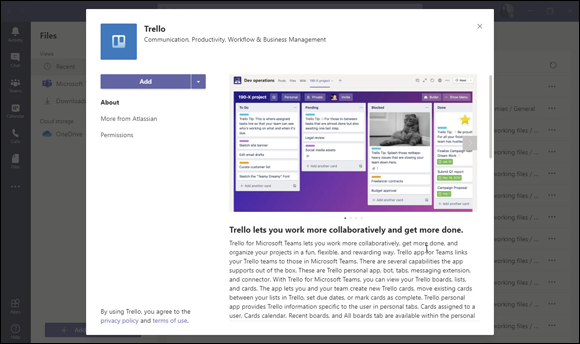
FIGURE 5-6: Adding the Trello app to a team.
When you add an app, you might not notice anything different about Teams right away. That is because different apps do different things, and some of that functionality is not obvious. For example, the Trello app allows you to add a special tab to your channels that is dedicated to Trello. Or you can use the Trello bot to interact with your Trello tasks by having it send messages in a channel. If you are using Trello, then you know to look for these things, but if you are not using Trello, you might not even be aware that the app was added. You can see exactly what apps are added to a team by selecting the ellipsis next to the team name and then selecting Manage Team. In the Manage Team settings, select the Apps tab to see exactly what apps are installed for the team.
You can also install an app as a tab or as a connector in a channel. The tabs at the top of a channel provide quick navigation to people in the channel. For example, you might add a tab for a Wiki or a tab for an app and the people in the channel can click on the tab to navigate between the channel discussion and the tabs you have added. To install an app as a tab, click the plus (+) sign next to the tabs at the top of the channel. The tabs that are included by default are the Files and Wiki tabs, but you can click the plus (+) sign to the right of those and add more. When you click the plus (+) sign, the Add a Tab dialog box appears, where you can choose which tab you want to add to the channel. (You learn more about this shortly, but you can skip ahead and check out Figure 5-10 to see the Add a Tab dialog box.)
To install a connector for a channel, click the ellipsis next to the name of a channel to open the More Options drop-down menu and choose Connectors from the list, as shown in Figure 5-7. The Connectors screen appears, as shown in Figure 5-8. You can connect a Teams channel to just about any popular software service out there on the Internet.
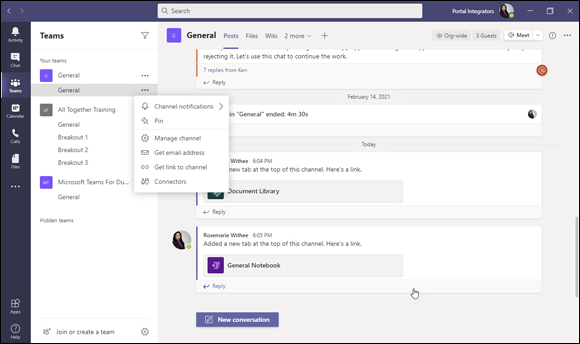
FIGURE 5-7: Accessing the Connectors option from the More Options menu in a channel.
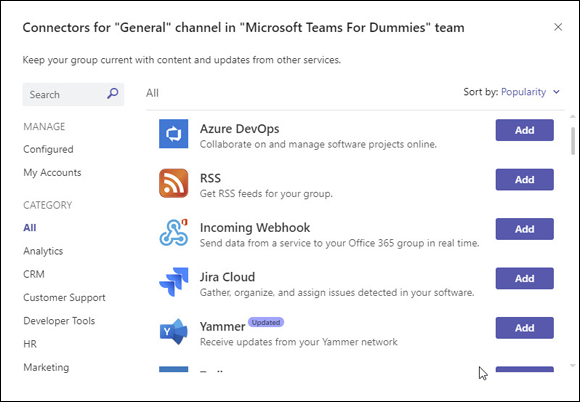
FIGURE 5-8: View the connectors available in a channel.
When you open the Connectors option for a channel, you get a filtered view of the app store. You can see the apps that are already installed that have connector options (notice the Forms app), and you can also add others.
Exploring Popular Apps
One of the best ways to understand how apps can extend Teams is by diving right in and installing and using them. In this section you discover some of the popular Teams apps Microsoft has developed. Next, you see some of the popular Teams apps that third-party companies have developed for Teams. (Note that these companies are called “third party” because they are not your organization and they are not Microsoft.) In addition to these apps, you can build your own Teams apps and upload them and use them, too.
Popular apps from Microsoft
Microsoft ships several apps for Teams that are enabled by default. You can also add more as you need them. I cover some of the most popular, and some of my favorites, next.
Office
Teams includes apps to integrate with Microsoft Office (Word, Excel, PowerPoint, and OneNote) by default. You don’t need to install anything. One of my absolute favorite integrations is with Microsoft Word. When I wrote this book, I wrote it within Teams using Microsoft Word. Figure 5-9 shows what this chapter looked like in draft form in Teams! So, where does the Word document that I am working on live? It lives in a SharePoint library in my Portal Integrators subscription of Microsoft 365. I added the SharePoint library using the SharePoint app for Teams, which I cover how to do next.

FIGURE 5-9: Using Microsoft Word inside of Microsoft Teams.
SharePoint
The SharePoint app for Teams lets you integrate SharePoint sites, libraries, and lists into Teams. As I mention in the previous section, I wrote this book using Microsoft Word inside of Microsoft Teams. But the files themselves live inside a SharePoint site in my Portal Integrators subscription of Microsoft 365. So how did I add the files from the SharePoint site into Teams? I used the SharePoint app. It is installed in Teams by default; all you need to do is use Teams to integrate with SharePoint.
One handy tip for working with SharePoint in Teams is to add a tab to a specific SharePoint library to a Teams channel. Here’s how to do so:
- Select the Teams icon in the left navigation pane to view all your Teams.
- Click the channel you want to integrate with SharePoint to open the channel in the main part of your screen.
Click the plus (+) sign to the right of the Files and Wiki tabs to add a tab.
The Add a Tab dialog box appears, as shown in Figure 5-10.

FIGURE 5-10: Adding a SharePoint Library as a tab in a channel.
Choose the Document Library option.
Notice you can also choose other popular apps that provide tab support, such as Excel, Forms, OneNote, PDF, and many others. If you don’t see what you are looking for right away, you can search for a particular app or select the More Apps link to see all the apps in the app store.
In the Document Library dialog box, choose the relevant SharePoint site and click Next, as shown in Figure 5-11.
The SharePoint sites that are in your same Microsoft 365 subscription show up by default. If you are adding a SharePoint site that lives somewhere other than in your Microsoft 365 subscription, you can enter the site link in this dialog box.

FIGURE 5-11: Choosing a SharePoint site from which to add a Document library as a tab.
Choose the library from those that are available in the SharePoint site and then select Next.
In Figure 5-12, I am choosing the SharePoint library called Documents.
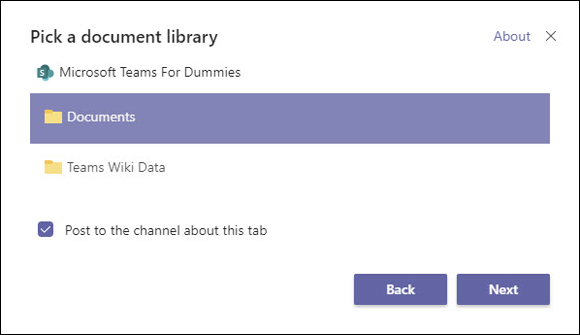
FIGURE 5-12: Choosing a Document library to add as a tab in a channel.
Enter a name for the tab and then select Save.
A new tab is now available in the channel, and clicking on it shows the files in the associated SharePoint library (see Figure 5-13). You can click an Office file and it will open inside of Teams and you can work on it. Pretty cool, don’t you think?

FIGURE 5-13: Viewing a SharePoint library as a tab in a Teams channel.
In addition to Office and SharePoint, I often use app integrations for Excel, Planner, OneNote, PowerPoint, OneDrive, Lists SharePoint Document Library, and Forms. Each of these has similar integrations as you just saw with Word and SharePoint.
Popular apps from third-party companies
The number of Teams apps available from third parties is astounding. As a consultant, I work with many different software services daily. Each of my clients seem to have their favorites that work for them. Following is a small spattering of some of the apps I have seen used in Teams. Just looking at the list of available apps in the Teams app store (see earlier in the chapter for information on how to find it), you will realize that just about anything you would want is probably listed in the store.

FIGURE 5-14: The documentation page for the Trello app for Microsoft Teams.
Freshdesk and Zendesk
Freshdesk (https://freshdesk.com) and Zendesk (www.zendesk.com) are popular support ticketing systems. For example, if you have a problem with a website, you might open a support ticket. Freshdesk and Zendesk are software products that manage those tickets. Both have a Teams app that allows you to get notified of tickets assigned to you and your team. The notifications come in the form of a bot that sends a chat to your channel. You can reply to the bot and send a message back to them to update the ticket. (Check out the section, “Getting Chatty with Bots” later in this chapter for more about working with bots in Teams.)
Asana and Trello
Asana (https://asana.com) and Trello (https://trello.com) are services for managing work. You can do things like managing your group’s work, projects, and tasks. When you install the Asana or Trello app in Microsoft Teams, you can view your projects directly in Teams and turn your conversations into Asana or Trello items. For example, while you are having a chat with your team, you might decide that there is an action item that needs to be done. You can use the Asana or Trello app to add this action item into Asana or Trello directly from the chat.
Dropbox, Box, and Google Drive
Teams integrates SharePoint and OneDrive behind the scenes to store your files, and you can add apps to integrate other cloud storage locations, too. Three of the popular cloud storage locations to add are Dropbox (www.dropbox.com), Box (www.box.com), and Google Drive (www.google.com/drive). When you add one of these apps to Microsoft Teams, you can work with the files stored in them just like how I work with Word files in SharePoint. Figure 5-15 shows the documentation Dropbox created for its Microsoft Teams app.
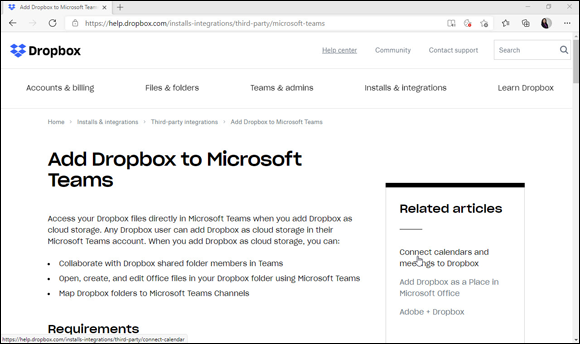
FIGURE 5-15: The documentation page for the Dropbox app for Teams.
Salesforce
Salesforce (www.salesforce.com) is a popular customer relationship management (CRM) service that lets organizations track their contacts, sales, and many other things. When you install the Salesforce app for Microsoft Teams, you can interact with Salesforce items without leaving Teams. I have seen companies that use Salesforce really love this app because they can be chatting and working with Salesforce without ever having to switch out of Microsoft Teams.
Kronos
Kronos (www.kronos.com) is a software company that makes popular work management software. I have seen companies use it to track time and other human resources items. When you install the Kronos app for Microsoft Teams, you can interact with Kronos using a bot, handling basic Kronos tasks right from Teams.
As I mention earlier in this chapter, there are many more apps you can install to integrate Teams with other software services. The rate at which companies are developing apps for Teams is astounding. Teams seems to be taking center stage as the software where people spend their time at work, and being able to integrate with it has become a priority. I am noticing a trend where other software, especially other Microsoft software, fade into the background and Teams becomes the gateway to use them. I experienced this firsthand when I used Microsoft Word to write this book never leaving the Teams app. I know from experience that the book files lived in SharePoint and the editing I did happened in Word. However, if I were brand new to Teams, I might never know nor care about the apps behind the scenes; I might just think everything happened in Microsoft Teams.
Integrating Teams with Microsoft Power Platform
The Microsoft Power Platform is a collection of software that helps users and organizations analyze data, build custom business functionality, automate workflows, and create custom bots called virtual agents. The collection consists of Power Business Intelligence (Power BI), Power Apps, Power Automate (formerly known as Flow), and Power Virtual Agents. These apps can be connected together, or to Microsoft 365 and hundreds of other apps, to build end-to-end business solutions. The Power Platform doesn’t require extensive coding skills, which makes it user-friendly and easy to roll out. Check your Microsoft 365 subscription to see if it is already included.
Microsoft integrated the Power Platform apps into Teams right away, as Teams is becoming the primary hub for productivity with Microsoft tools. So, it is a good thing you bought this book and are diving into Teams!
Power BI
Power BI is a data analysis and visualization tool from Microsoft. It is available both as a self-service app or as an enterprise solution. Check your Microsoft 365 subscription to see if Power BI is already included. If not, you can subscribe to it as an add-on for a monthly fee.
The amount of data businesses collect and use is growing exponentially. The data is also changing rapidly. Being dependent on a spreadsheet that might change daily, or weekly, and that needs to be shared in email, is inefficient. Power BI allows you to connect to nearly any type of data source, including Excel and SharePoint, and pull it into a single collection. Data can be updated and shared in real time. Power BI has robust data visualization capabilities. There are numerous pre-made graphs and charts available to choose from. With Power BI, not only is data updated in real time — so are the visuals. This combination allows decision-makers to have important data available to them right away.
Power BI is available as a Teams app for easy integration with Teams. You find Power BI in the app store. Select the Apps icon on the lower-left side of your Teams screen and search for Power BI. If you already have a Power BI account, you won’t need to log in again. If you don’t yet have a Power BI account, you will need to sign up for one before you can log in.
Power Apps
Almost every business uses some type of software, and it is usually customized to meet specific needs. Hiring developers to develop and customize the software you need is expensive, and it is not always easy to keep the developers and business people on the same page.
Microsoft created Power Apps as a no-code solution for building software. The idea behind Power Apps is that business people can build their own software without the need of a professional developer. Microsoft focused on making Power Apps integrate with the rest of the Microsoft products — most especially with Teams.
Power Apps is an add-on to your Microsoft 365 subscription. Currently, it is priced at $10 a month per app or $40 a month for unlimited apps.
You can integrate the apps you build with Power Apps into Teams. You will find Power Apps in the app store. Select the Apps icon on the lower-left side of your Teams screen and then search for Power Apps.
Power Automate
The third power to the Microsoft Power Platform is Power Automate. (Power Automate used to be known as Microsoft Flow.) Microsoft created Power Automate to help with the repetitive and mundane tasks everyone knows as grunt work. We have all been there where we wished someone could just automate a mind-numbing task. Much like Power BI and Power Apps, Power Automate was created for you to use and automate your mundane tasks.
Power Automate is another add-on to your Microsoft 365 subscription. Check your licensing to see if you already have it.
You can integrate the automations you create with Teams. As with the other Power Platform apps, Power Automate is in the app store. Select the Apps icon on the lower-left side of your Teams screen and then search for Power Automate.
Power Virtual Agents
Power Virtual Agents is a fancy name for chatbots. A chatbot is an artificial intelligence (AI) software application designed to simulate conversation with a live person over an instant messaging platform. Chatbots have increased in popularity in the last couple of years. Organizations and businesses have started to use chatbots as the first line of customer support. In the beginning, chatbots could only be programmed to answer simple if/then scenarios. But with the advances in artificial intelligence, the chatbots are literally getting smarter!
To use Power Virtual Agents, you need to add it to your Microsoft 365 subscription. As of this writing, the subscriptions costs $1,000 a month for 2,000 chatbot sessions. But as usual with Microsoft licensing, be sure to check current pricing.
You can integrate the Power Virtual Agents with Teams by adding it from the app store. Select the Apps icon on the lower-left side of your Teams screen and search for Power Virtual Agents.
Setting Permissions for Apps
You can limit the access the apps you add to Teams have to each of your devices. For example, you can turn on and off access to your microphone, speakers, and camera. You can allow apps to open links in external applications or access your geographic location. You can also allow apps to send notifications or even access the MIDI format for sending sounds between devices. App developers can specifically request these permissions and when they do, you will see a notification when you install the app asking for the permissions. You can explicitly turn off these permissions however, as outlined below. You can set these permissions for every app across the board or you can customize them per app.
To set the permissions the Teams apps have for your device, follow these steps:
- Log in to Teams and select Settings from your profile drop-down menu.
On the Settings screen, select Permissions in the left navigation pane.
The Permissions screen appears, as shown in Figure 5-16.
- Set the toggles next to the Permissions settings you want to turn on and off.
Close the window by selecting the X in the top-right corner of the screen.
You don’t need to save the settings; they are saved automatically as you adjust them.
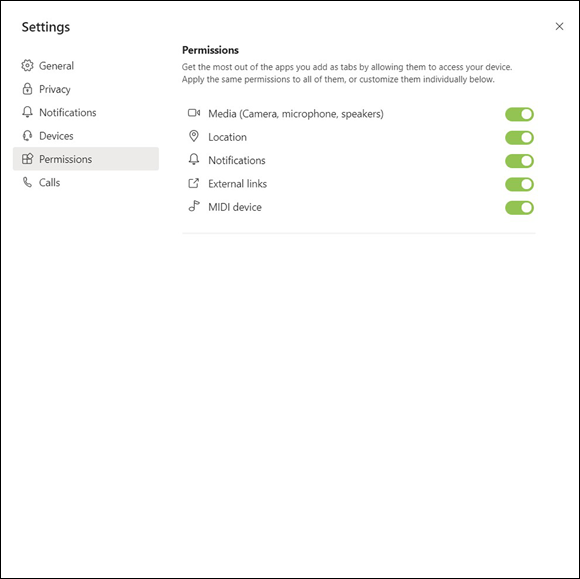
FIGURE 5-16: Setting the permissions that Teams apps you install have to your device.
Getting Chatty with Bots
A bot, short for robot, is a software program you can interact with by sending messages to it in a channel. Bots have been around a long time, becoming popular with Internet Relay Chat (IRC) back in the 1990s.
When you install a Teams add-on app, you might be installing the bot and not even realize it. A bot is just a type of app you can use in your channels. You can send messages to it in order to have it do things for you. For example, when you install the Freshdesk app, you are also installing the Freshdesk bot.
I like to think of the bot as the face of the app I am using in a channel. The bot will send messages to the channel, maybe a Freshdesk ticket update, and I can reply and interact with the bot, which can then send my ticket updates back to Freshdesk. Even though the bot is just a software program, I like to think of bots as a virtual concierge to the services they represent.
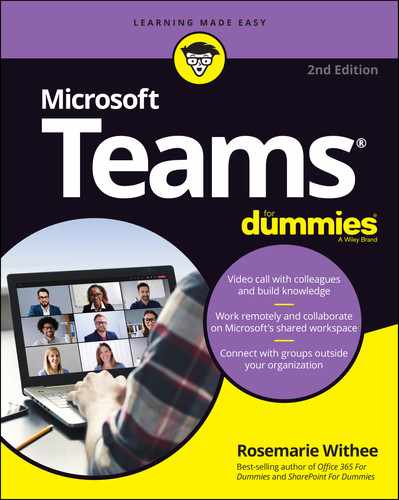
 A connector is a connection to some other software service that allows that service to provide updates directly to Teams and into your channel. For example, if you add a connector for Twitter, you can see tweets directly in the channel. I like to think of a connector as a way to stay up to date with things that are happening outside of Teams. Connectors let me stay connected with other software services without having to leave my Teams channels.
A connector is a connection to some other software service that allows that service to provide updates directly to Teams and into your channel. For example, if you add a connector for Twitter, you can see tweets directly in the channel. I like to think of a connector as a way to stay up to date with things that are happening outside of Teams. Connectors let me stay connected with other software services without having to leave my Teams channels. Covering all the apps available for Teams is beyond the scope of this book. I cover a few of the most popular in the next section. Go ahead and install some and explore them. I find new apps all the time that I didn’t even know existed!
Covering all the apps available for Teams is beyond the scope of this book. I cover a few of the most popular in the next section. Go ahead and install some and explore them. I find new apps all the time that I didn’t even know existed! You can think of the apps that you add as tabs to your device as a mini web browser embedded into Teams. The tab can interact with your computer, like a web browser, but it must be provided permission to do that. If you open a website that wants to use your webcam and microphone, the web browser will ask you if the site has permission to do that. It is the same concept in Teams.
You can think of the apps that you add as tabs to your device as a mini web browser embedded into Teams. The tab can interact with your computer, like a web browser, but it must be provided permission to do that. If you open a website that wants to use your webcam and microphone, the web browser will ask you if the site has permission to do that. It is the same concept in Teams.